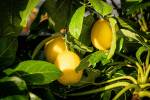Thinking, living locally should help green Nevada
The greening of Nevada is under way, but the ultimate goal of true sustainability is no easy task. Even so, there is a simple and very powerful concept that can guide us much of the way: localization. By its very nature, it applies to everyone and could have a profound impact on our homes, making them more affordable, independent and self-sufficient.
Localization means doing as many things as possible as close to home as we can. It also means learning to respect and work within the environmental boundaries of our region. Here are some examples:
* Local food production improves freshness, reduces transportation cost and lessens environmental impacts.
* Rooftop solar energy cuts transmission losses, reduces the burden on the grid, lowers CO2 emissions and saves water.
* Using locally available water more efficiently eliminates the need for massive, expensive and damaging systems designed to take it from distant areas that already depend on it.
* Working closer to home reduces commuting time, saves money and provides more time with family.
* Frequenting locally owned businesses improves our economy, keeping dollars circulating in the community.
The impacts of peak oil will have far-reaching effects on almost everything we currently take for granted. As we transition to a post-carbon world, localization will help fill the gaps created by rising fuel prices or scarcity.
Here's what I think Southern Nevada could look like in 20 years or so.
Neighborhoods will evolve, thanks to some visionary code and zoning changes. Citizens won't use cars for basic needs as local grocery stores and micro-businesses spring up within walking distance of most homes. These will provide income for nearby residents and act as social hubs, bringing neighbors together who were once strangers.
New-found friends will help each other with local organic gardens as toxic lawns and landscapes are transformed to edible plants that are both visually appealing and nutritious. Each harvest will be shared among friends and any excess will be sold to local grocers or restaurants. Local organic food is healthier and provides the additional benefit of increased physical activity, turning couch potatoes into juicy tomatoes.
Subsurface watering systems will deliver only what is needed, eliminating waste. Watering systems will never use potable water, which in our climate should only be for drinking, cooking and bathing anyway. Gray water will be processed on-site through simple filtration systems and then used for both indoor and outdoor plants. Buildings and landscapes will capture rainwater using underground cisterns, maximizing the value of every drop.
Toilets will not use any water at all since wastes will be safely processed locally in composting systems that produce clean, healthy and valuable soil nutrients. These nutrients will help build local soils, enhancing plant growth. This will come to be viewed as much more desirable than the current practice of mixing human waste with industrial toxins as we send them back into our source of clean drinking water. The toxic sludge from waste treatment plants across the country is already being used as fertilizer on industrialized food crops, though most folks are unaware of this dangerous practice. Local processing of human waste turns a liability into an asset.
Thus new communities will no longer require expensive sewer infrastructure. Pollution levels in local water supplies will plummet. These localization strategies will save money for homeowners, developers and local governments, ultimately reducing the tax burden currently needed for the expensive maintenance of centralized sanitation systems.
By reusing every gallon of water at least once and perhaps more, energy-intensive water pumping and treatment also will be greatly reduced, saving homeowners money and further reducing pollution.
Every home will become very energy efficient. Older homes will be improved through affordable energy-efficiency programs implemented by local governments. Eventually our homes will produce more power than they need and the excess will charge electric vehicles or plug-in hybrids, from bikes to full-size cars and trucks. Gasoline consumption will drop by 80 percent or more.
A smart energy grid will evolve that will function interactively, somewhat like the Internet does now. As localized efficiency improvements are implemented in business and industry, our power needs will drop enough to close the Reid Gardner coal plant in Moapa, the dirtiest in the nation, without having to build additional fossil or nuclear energy facilities. Old plants will remain online to provide the reduced amount of base load power needed until the full transformation to geothermal and other renewable sources is complete.
Every step in this journey of localization will result in protecting valuable natural resources while also reducing pollution. It will create a more resilient and self-sufficient community while improving and diversifying our economy. It also will provide incredible economic opportunities as businesses adapt to deeper shades of green.
Our future homes will be less dependent on services like power, gas, water and sewers. They will provide better habitat for us and native species alike. They will foster a greater sense of community, human interaction and well-being. Isn't that what green living is all about?
Steve Rypka is a green living consultant and president of GreenDream Enterprises, specializing in renewable energy, green building, alternative transportation and lifestyle choices for both residential and commercial clients. The company is committed to helping people live lighter on the planet. Rypka can be reached via e-mail at steve@greendream.biz. More information relating to this column is posted at www.greendream.biz.























